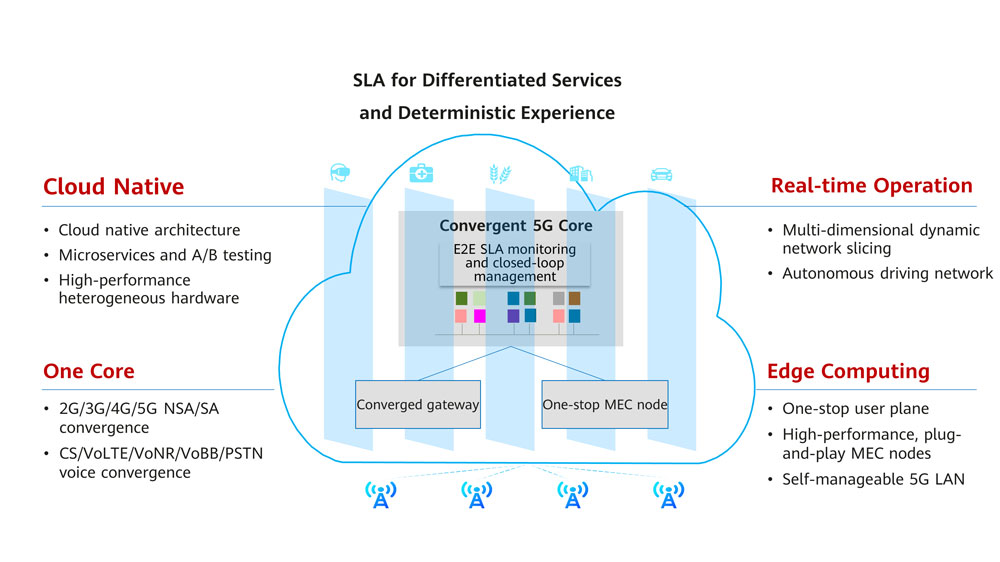Build a 5G Core for Deterministic Networking
Latest GSA statistics show that by the end of this May, 386 operators in 125 countries or regions had announced their investment in 5G, and 95 of them had launched 5G services in compliance with 3GPP specifications. The accelerated commercial launch of 5G around the world will deliver a superior service experience to individuals, families, and enterprises, while unleashing the potential of industry digitization and creating new opportunities for operator growth.
Digitally Transforming Industry Requires Differentiated Services and Deterministic Experience
Conventional 2G, 3G, and 4G networks mainly serve individual users. The network architecture is designed around a best-effort service paradigm, which does not inherently support guaranteed delivery. With sufficient resources, user requirements can be met. However, once networks run out of resources, some tasks might be throttled down or preempted, and user experience cannot be guaranteed. Accelerated industry digitalization in the 5G era poses higher requirements on networks. Industry customers require differentiated services and deterministic experience, and the resulting applications have diverse requirements on networks. For example, remote metering requires many connections but is not sensitive to bandwidth or latency. In contrast, services such as telemedicine and self-driving require that network latency, security, and reliability are maintained within a deterministic range. To give perspective, to reach 99.9999% reliability, downtime must be limited to no more than several seconds for the entire year. Another example is the campus network. A common requirement of this type of application is that user and service data must be isolated within the campus. To achieve this, public networks need to be used as dedicated networks.

Figure 1 Ever-changing demands for the network
After analyzing and practicing in over 100 applications across more than 10 industries, Huawei put forth three main requirements for 5G that is expected to drive industry digitalization: differentiated networks with orchestratable capabilities, dedicated networks with guaranteed data security, and self-service (DIY) networks with automated management. Networks built with deterministic capabilities and one or more of these dimensions implement what is called 5G Deterministic Networking (5GDN). In May 2019, Huawei proposed the innovative 5GDN concept, which leverages 5G network resources to build predictable, adaptable, verifiable, and deterministic dedicated mobile networks, delivering differentiated service experience.
Build a CORE-centric 5G Deterministic Core Network
The 5G core network manages information and resource scheduling, including network topology, user access, user data, and service quality, for the entire 5G network. It is the key to realizing 5GDN. To help operators roll out 5GDN, Huawei released the industry's first DN-oriented 5G Core solution in February 2020. Huawei also proposed to plan and build 5GDN around the idea of "Cloud Native (C), One Core (O), Real-time Operation (R), and Edge Computing (E)." The solution runs on the cloud native platform and supports microservice-based 2G/3G/4G/5G full convergence. Leveraging super-performance heterogeneous MEC, multi-dimensional dynamic network slicing, and core network automation engine, it can provide differentiated network capabilities and deterministic networking experience for various industries.

Figure 2: Huawei's CORE-centric 5G Core
The CORE-centric 5G Core network has the following advantages:
Huawei and world-leading operators and industry partners have applied 5GDN successfully in a wide range of fields, encompassing multimedia, manufacturing, energy, healthcare, and Internet of Vehicles (IoV). They also showcased projects in many vertical industries like smart ports, smart grids, smart manufacturing, and AR/VR (specifically, cultural tourism and advertising). In the report "5G Mobile Core: Competitive Landscape Assessment" published by GlobalData, Huawei earned the leadership position for two consecutive years. In the future, Huawei will continue to join hands with world-leading operators and industry partners to promote industry consensus, strengthen the industry ecosystem, and accelerate industry development.